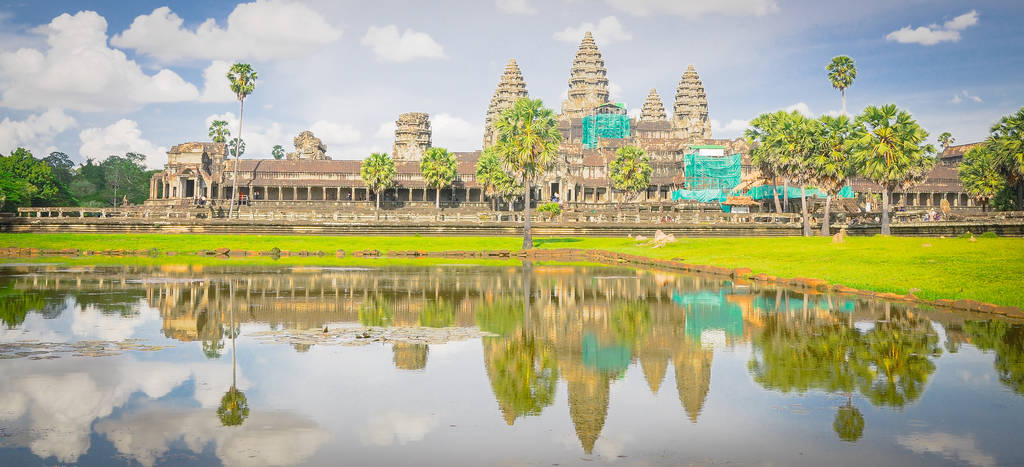You’ll catch Angkor Wat at its best between November and February, when temperatures hang between 20–30°C (that’s 68–86°F—perfect temple trekking weather!).
Skies are blue, humidity is low, and the sunrises? Absolutely epic. Sure, you’ll dodge a few more tourists, but the stunning light and cooler evenings make it worth it.
Key Takeaways
- The prime visiting season for Angkor Wat is from November to February, offering cooler temperatures and less humidity.
- Clear skies during this period provide ideal conditions for photography and sightseeing around the temples.
- Visitor numbers peak during these months, resulting in livelier temple sites and bustling tourist activity.
- Comfortable evenings in the prime season allow for enjoyable outdoor dining and exploring Siem Reap’s local culture.
- Advanced bookings for accommodation and tours are recommended due to high demand during the prime season.
Understanding Angkor Wat’s Climate
If you’ve ever wondered what it’d feel like to investigate an ancient wonder in a climate that’s part sauna, part paradise, Angkor Wat’s got you covered!
You’ll step right into a tropical monsoon climate—hot and humid almost all year, with climate impacts that shape every adventure. The year splits into two seasons: dry (November–April) and wet (May–October).
Prepare for seasonal variations: April and May crank temperatures up to a sizzling 36°C (sometimes over 40°C!), while December chills around 31°C.
Humidity sticks around, especially in the wet season when it can hit 80-90%. Rains arrive fast and heavy, mostly in late afternoons.
If you crave freedom, just know: Angkor Wat dishes out sunshine, mists, and heat waves—never boring!
Exploring the Peak Season: Weather and Experience
Sun-streaked skies, gentle breezes, and weather that won’t melt your flip-flops—welcome to Angkor Wat’s peak visiting season!
If you crave freedom to roam, November to February is pure bliss: 20-30°C (68-86°F), low humidity, and open skies for perfect temple photos. It’s dry, so roads are easy for adventure, and you’ll find tours in full swing.
Still, you’re sharing this slice of heaven with fellow adventurers.
- Clear mornings—essential for jaw-dropping sunrise shots
- Comfortable evenings for savoring local cuisine under the stars
- Bustling energy at major temples (expect crowds!)
- Best access for thorough investigations into authentic cultural experiences
Get ready for a trip that mixes ancient wonder with modern thrills—just don’t forget sunscreen, your camera, and a willingness to chase freedom!
Navigating the Hot Season: Challenges and Opportunities
Although Angkor Wat’s hot season turns up the heat past “toasty” and straight into “Wow, I could fry an egg on these stones,” there are some big reasons it just might be the right time for your adventure. You’ll dodge crowds, enjoy a quieter pace, and maybe even score a deal.
But don’t let the numbers (we’re talking 35–40°C!) surprise you—heat exhaustion is real, and smart travel planning matters. Early starts, long midday breaks, and high-quality hydration strategies keep you energized and ready for meaningful cultural experiences.
Embracing the Rainy Season: Rewards and Considerations
Once you’ve braved the dry season’s sizzling stones, you might think rain sounds like a blessing—and honestly, visiting Angkor Wat during the rainy season is a total game-changer.
Freedom-seekers, this is your shot at ultimate adventure! You’ll welcome rainy season benefits beyond cool splashes: fewer crowds, lush greenery, and a peaceful stillness you rarely find anywhere else.
Adventure awaits—embrace the rainy season’s lush scenery, tranquil moments, and rare freedom from crowds at Angkor Wat.
Imagine wandering ancient stones under a gentle drizzle, exploring tranquility in near solitude.
- Vibrant “Green Season” landscapes: Lush, vivid greens and filled moats transform the temples.
- Epic photo ops: Misty rain, reflections, and saturated colors—no editing needed!
- Escape the crowds: Up to 80% fewer visitors—yes, really!
- Affordable adventure: Save serious cash on hotels and tours.
Catch some rain (and freedom) while making epic memories!
Benefits of Visiting During the Shoulder Seasons
If you’re looking for that perfect sweet spot between Angkor Wat’s bustling crowds and steamy monsoon downpours, the shoulder seasons are your golden ticket.
You’ll waltz right past long lines, scoring prime photo ops without hundreds of tourists in every frame—now that’s freedom!
Welcome those shoulder season advantages: fewer people, budget-friendly hotel deals, and easier access to even the iconic temples.
For sharp travel planning tips, book in October, November, March, or May.
You’ll catch lush, green landscapes and water-filled moats in late October or November—like nature hit refresh!
Enjoy your independent wanderings, soaking in wild, dramatic skies and serene surroundings.
Honestly, who doesn’t want temples practically to themselves?
The shoulder season turns exploration into a truly personal adventure.
Temperature and Rainfall Patterns Throughout the Year
With Angkor Wat’s mysterious temples calling your name, you’ll want to know exactly what weather to expect before you set off!
Prepare yourself for some real temperature variations and a wild ride with rainfall frequency. Cambodia’s tropical climate means you’ll find two distinct moods:
- Cool, dry bliss (Nov–Feb): Temps hover between 22–32°C (72–90°F) with barely any rain.
- Blazing hot dry season (Mar–Apr): Temperatures skyrocket—April often tops 38°C (100°F)!
- Soaked and steamy (May–Oct): High humidity and plenty of rain—August and September mean daily downpours.
- Quick changes: October/April bridge the seasons, so expect shifting patterns!
Plan around what suits your freedom-loving spirit.
Want sun? Visit early in the year.
Don’t mind getting drenched? Wet season’s perfect for adventure!
Managing Crowds for a Better Experience
Although Angkor Wat’s ancient beauty attracts travelers from every corner of the globe, you don’t have to let big crowds kill your vibe!
Here’s your ticket to freedom: master crowd dynamics with smart timing. Dodge the rush by exploring from 11:00 AM to 2:00 PM—yes, it’s hot, but you’ll find rare temple solitude while everyone else is lunching.
Skip the classic clockwise routes and start at Ta Prohm right at opening, or use Angkor Wat’s east gate for a quieter entrance.
Welcome offbeat temples like Baphuon, Preah Palilay, or venture to Beng Mealea for a true escape.
Customize your route, hire a flexible tuk-tuk driver, and don’t be afraid to go off-script.
Your adventure, your rules—enjoy the temples YOUR way!
Sunrise and Sunset: The Best Moments to Explore
Ready to level up your Angkor Wat experience? Welcome freedom at its peak by syncing your visit with the awe-inspiring sunrise rituals and sunset reflections!
Unlock the ultimate Angkor Wat adventure—embrace magical sunrises and sunsets for memories that last a lifetime
There’s nothing like beating the sun to the temple or soaking in those final golden rays before night falls. Trust me, it’s pure magic—just plan with intention.
- Arrive before 5:00 AM for sunrise; leave your hotel by 4:00-4:45 AM for the best sunrise rituals.
- Head to the North or South reflection pools for iconic sunrise views. Want fewer people? The East side is your friend!
- Sunset reflections shine at Phnom Bakheng (arrive early—spots fill fast), Pre Rup, or peaceful Srah Srang.
- Dry season (Nov-Apr) delivers the clearest, most vibrant skies—nature’s ultimate show!
Why settle for ordinary? Time it right, and you’ll remember these moments forever!
Photography Tips for Every Season
Ever wondered how to capture Angkor Wat at its absolute best, no matter when you visit?
Mastering seasonal photography is all about flexibility. In dry season, chase that crisp golden light—but watch out for crowds! Patience pays off when snapping iconic sunrise shots.
Hazy skies from January to March? Flip it—shoot dramatic “red ball” sunsets.
Rainy season turns everything lush green, with moody clouds and fewer tourists. Grab reflection shots in puddles or moats after storms.
Dial in your lens selection: bring a wide-angle (16-35mm) for epic temples and details, plus a zoom (24-70mm) for versatility.
Telephoto (70-200mm) lenses help you isolate statues or distant carvings. Keep your gear protected (rain cover, dry bag)—and don’t forget spare batteries!
Budgeting and Events: Timing Your Trip Right
Once you figure out when to go, your wallet—and total experience—can swing wildly!
Want to chase freedom on a shoestring? Then timing is EVERYTHING at Angkor Wat.
Get smart with these budget tips and festival insights:
- Low Season steals: Grab hostels for $6-10/night. Dorm life gets you fresh friends and big savings!
- Festival fever: Khmer New Year (April) and Water Festival (November) spike crowds AND rates, but you’ll catch epic celebrations. Book ahead or risk missing out!
- Transportation tricks: Rent a bike ($1-3/day) for ultimate freedom or negotiate tuk-tuk prices. Fun and cheap!
- Passes and perks: Angkor Passes get cheaper per day the longer you stay. Scope out free activities—night markets and river walks are priceless.
It’s your trip—own it!
Conclusion
Picking the perfect time to visit Angkor Wat really depends on your vibe! Want cool, dry air? November to February’s for you. Prefer fewer crowds and lush, moody skies? The rainy season’s your jam—just grab an umbrella! Remember, sunrise and sunset are magical, no matter what month you’re there. Whatever you choose, pack smart, prep your camera, and prepare for an adventure you’ll never forget. This temple’s waited centuries—don’t keep it waiting too long!



